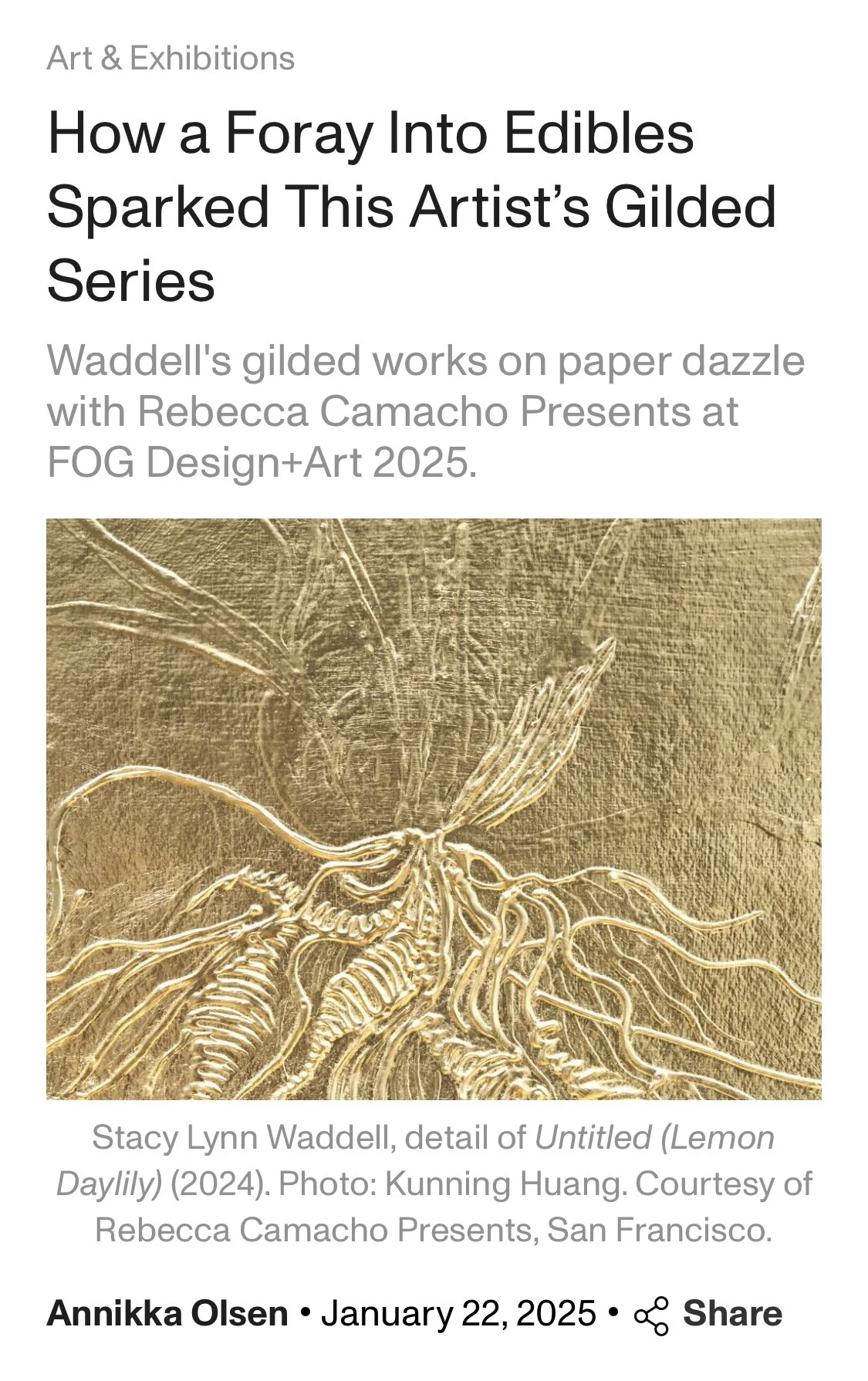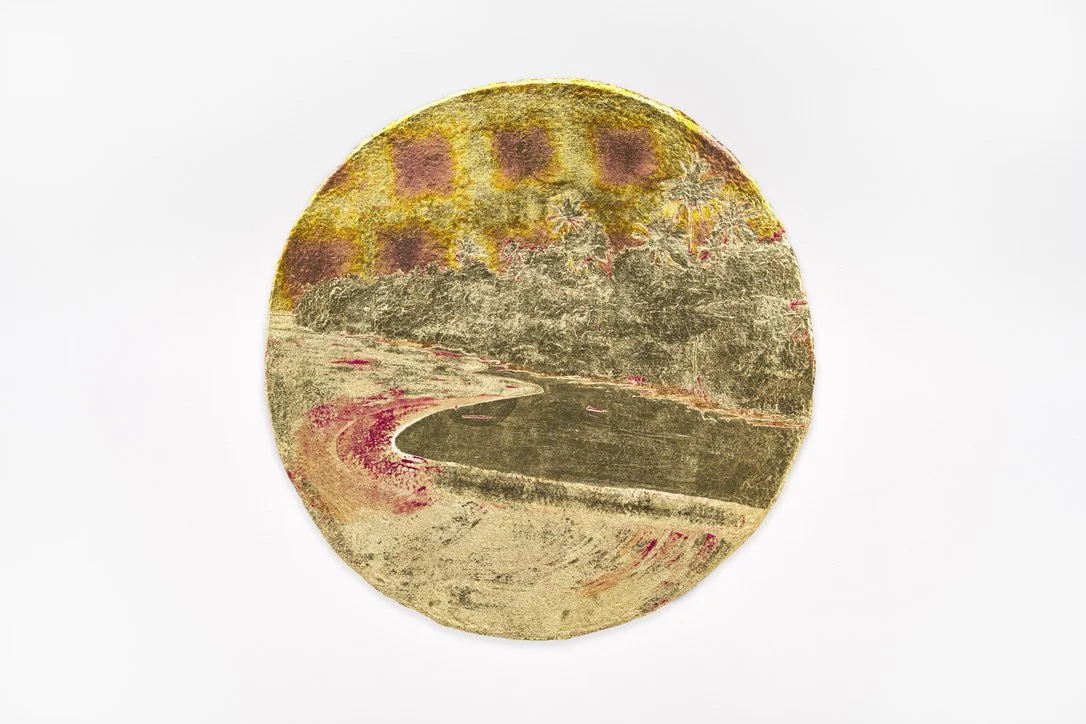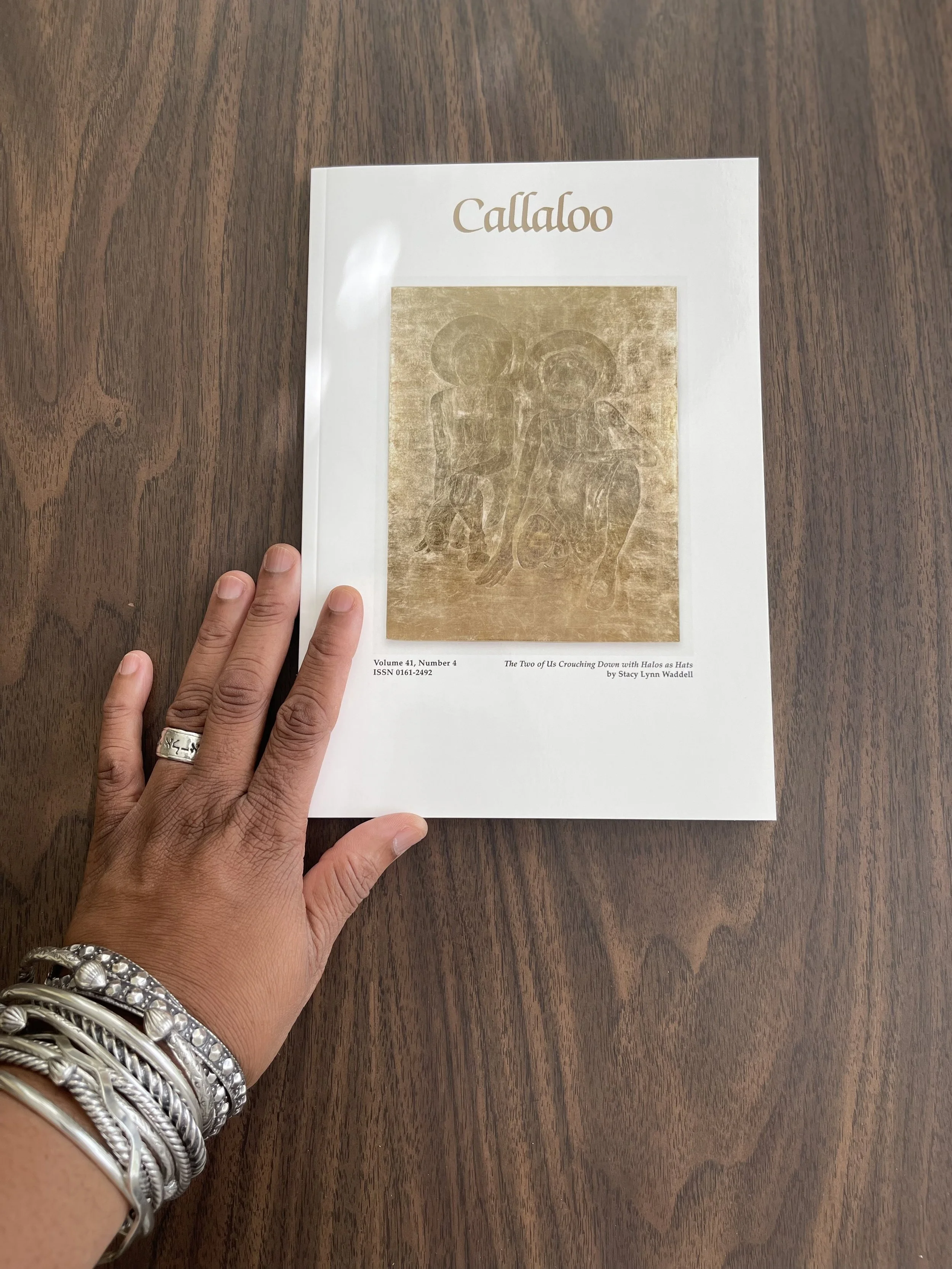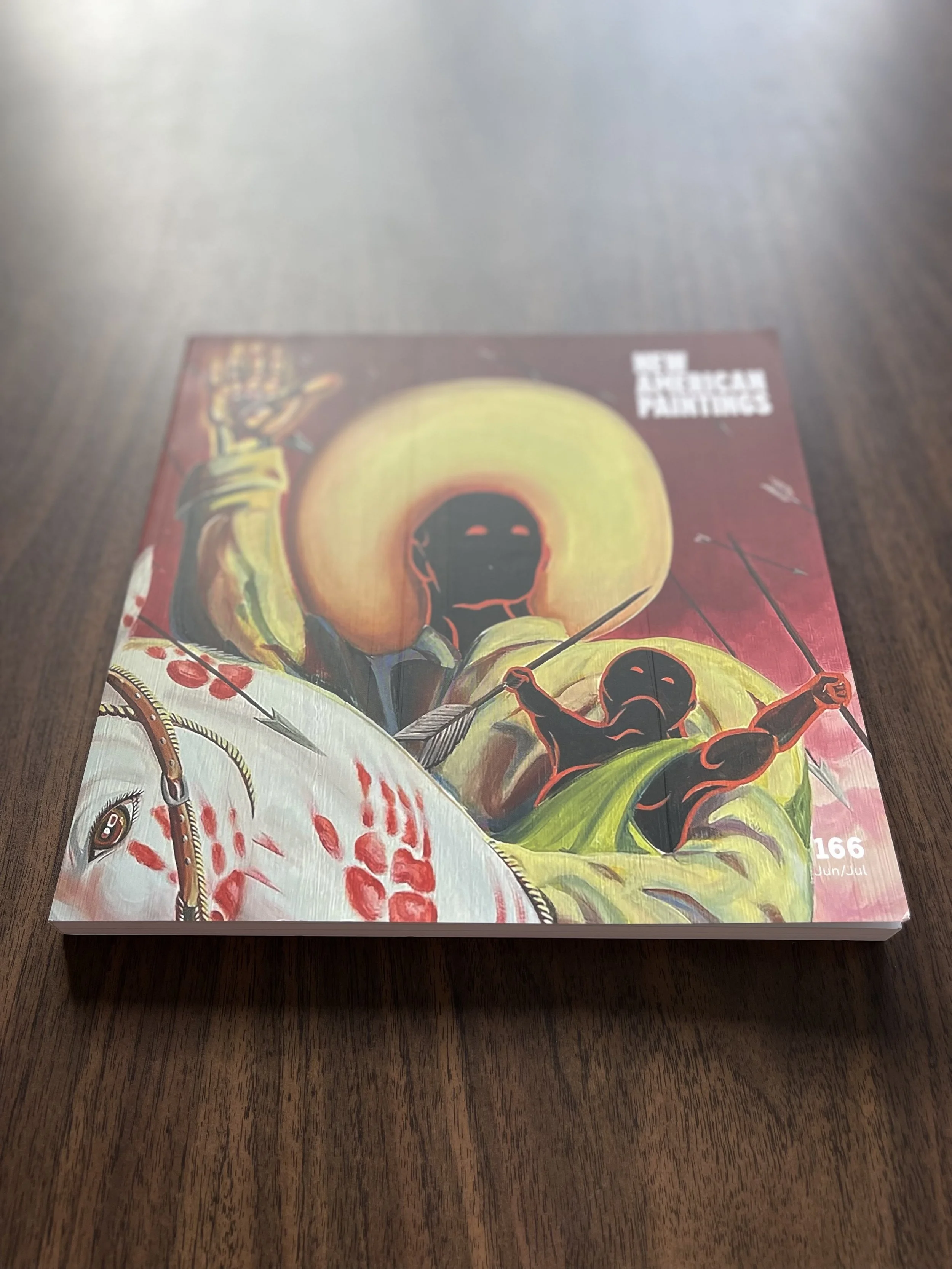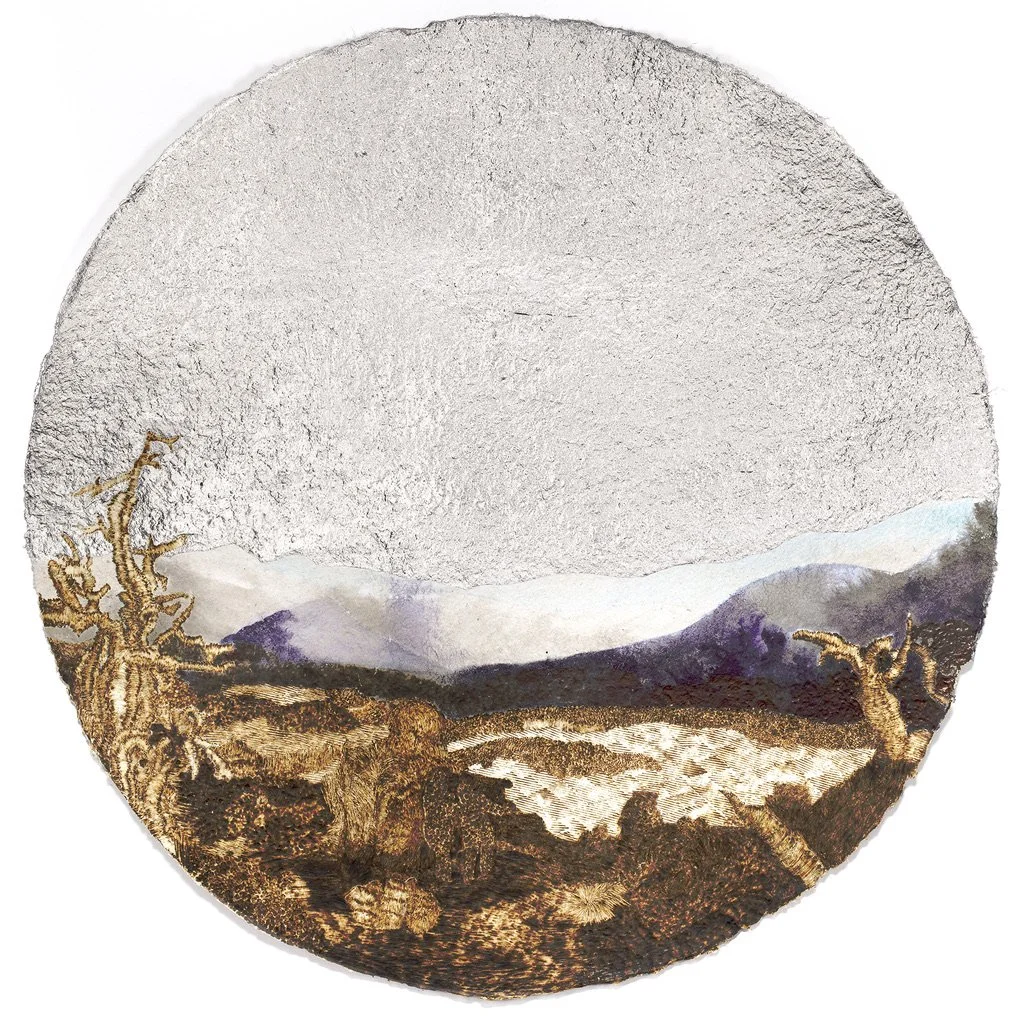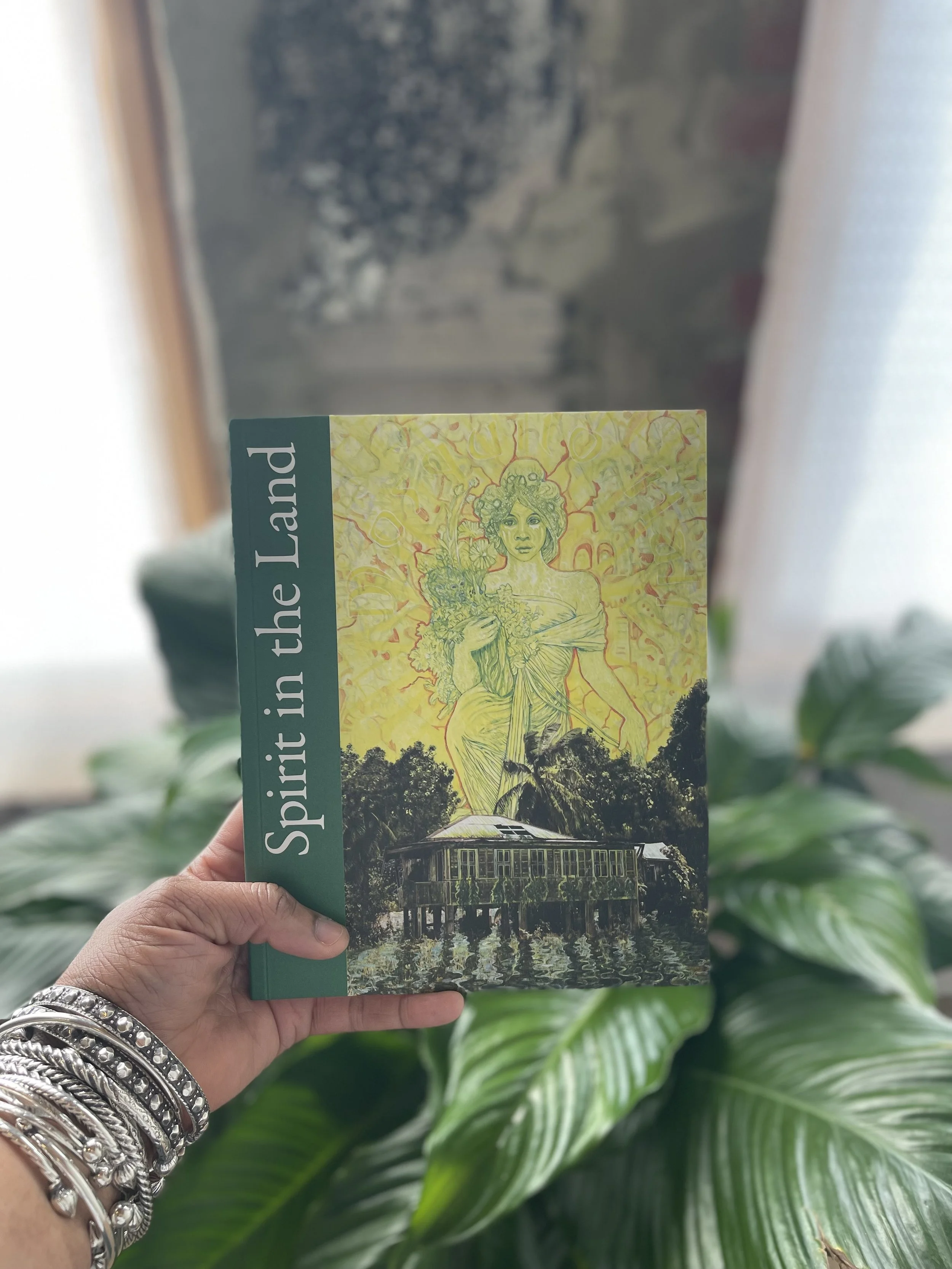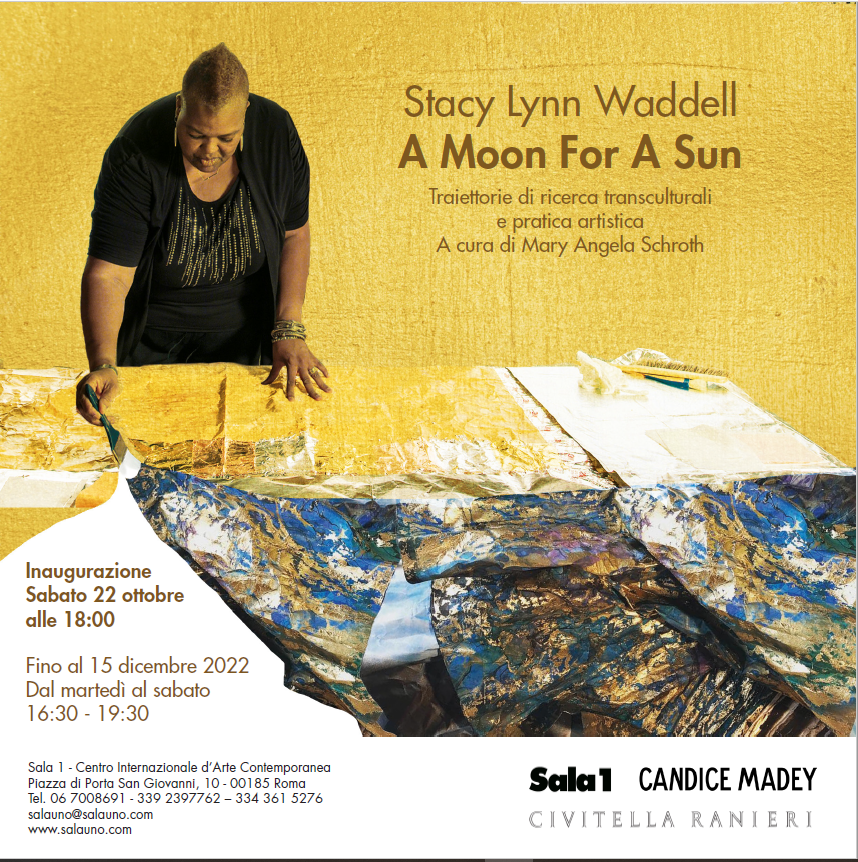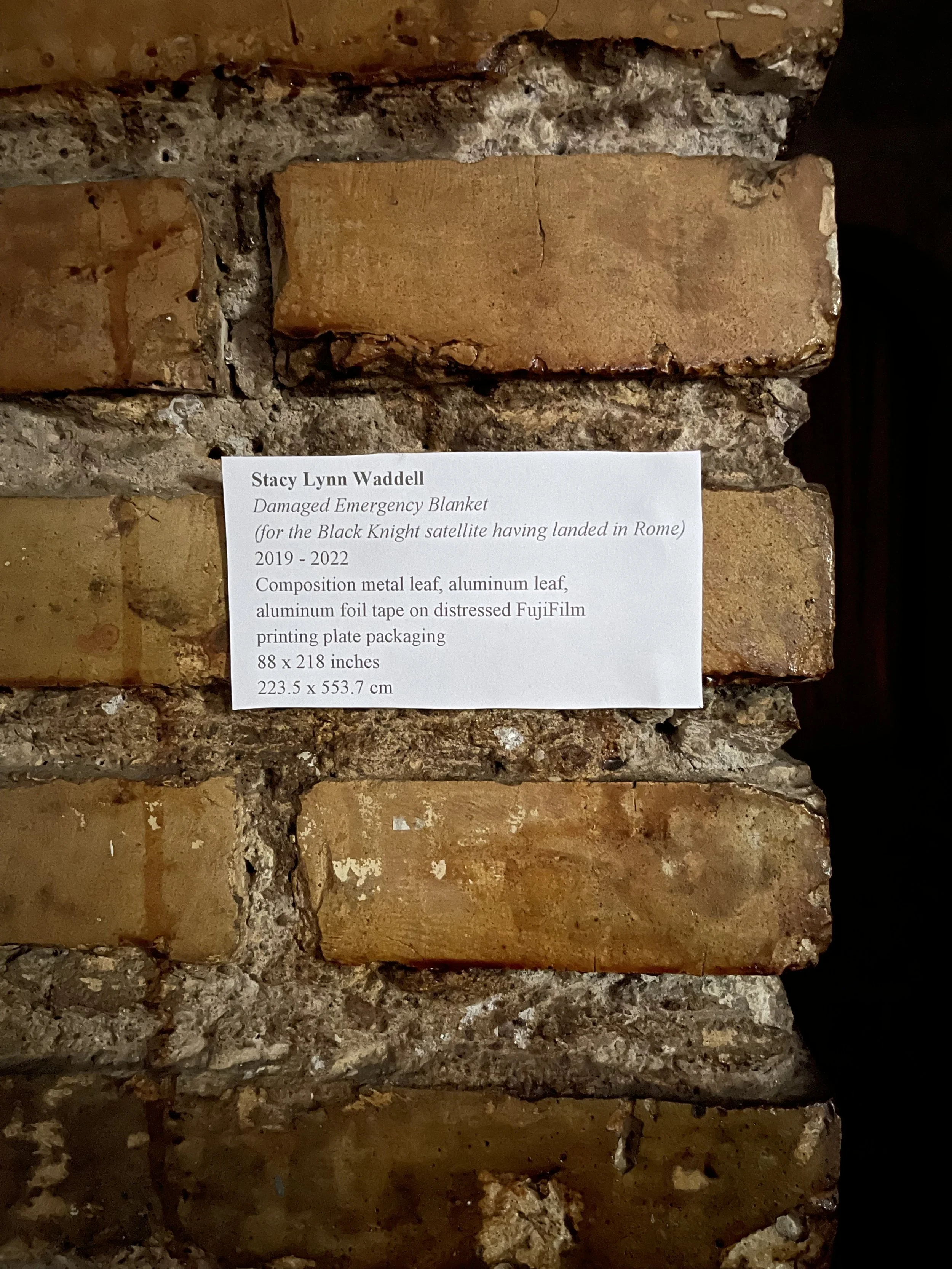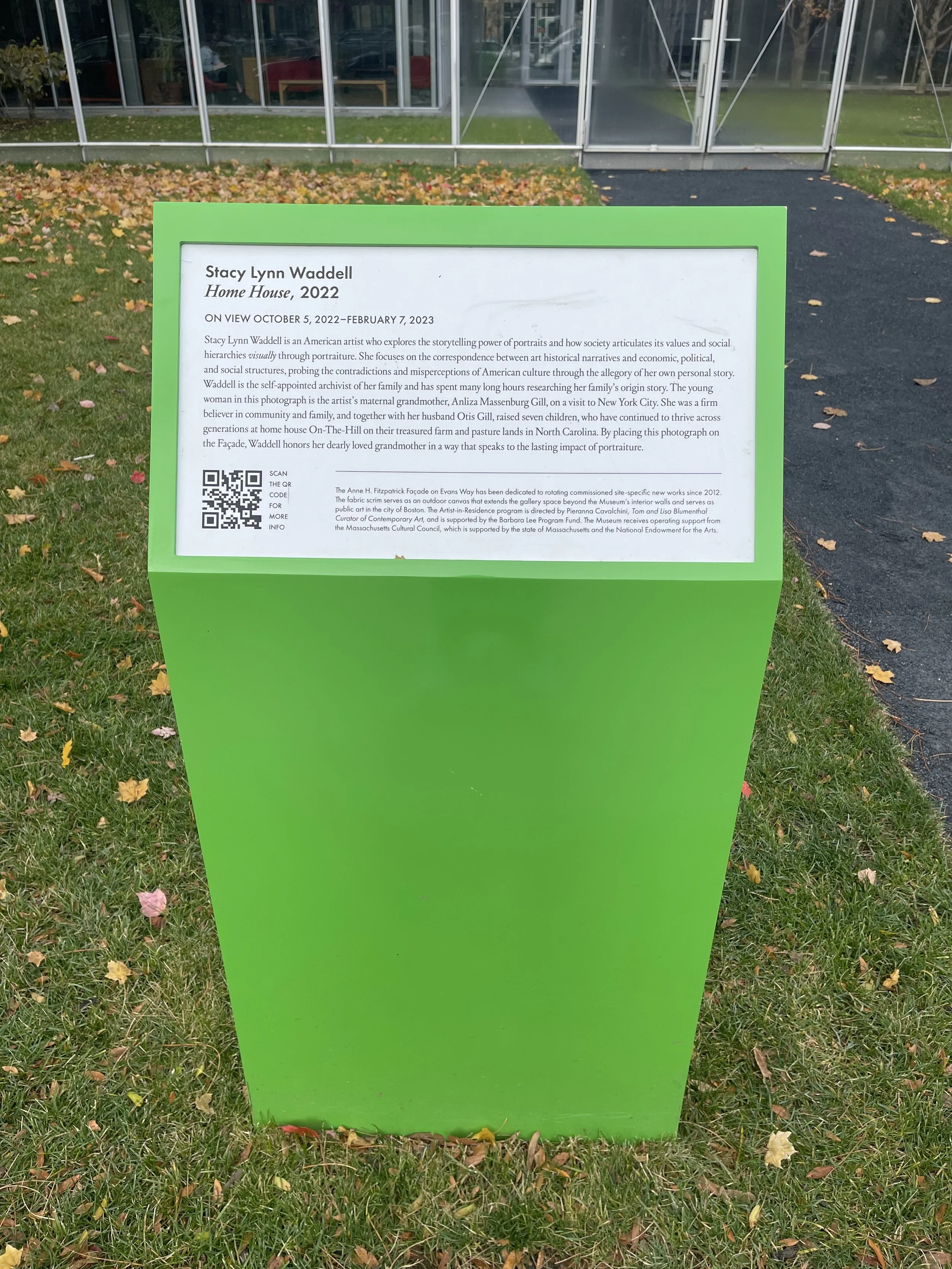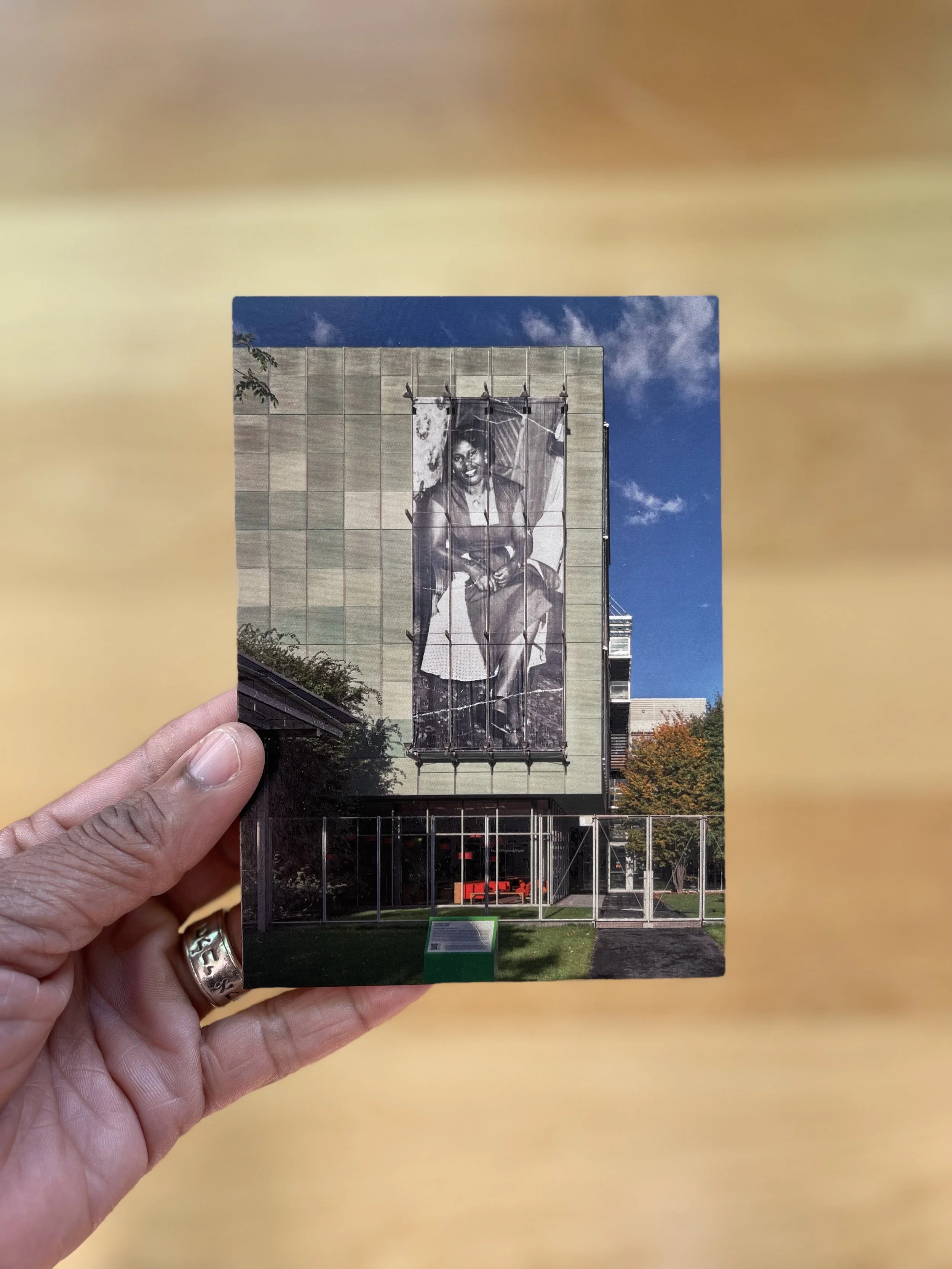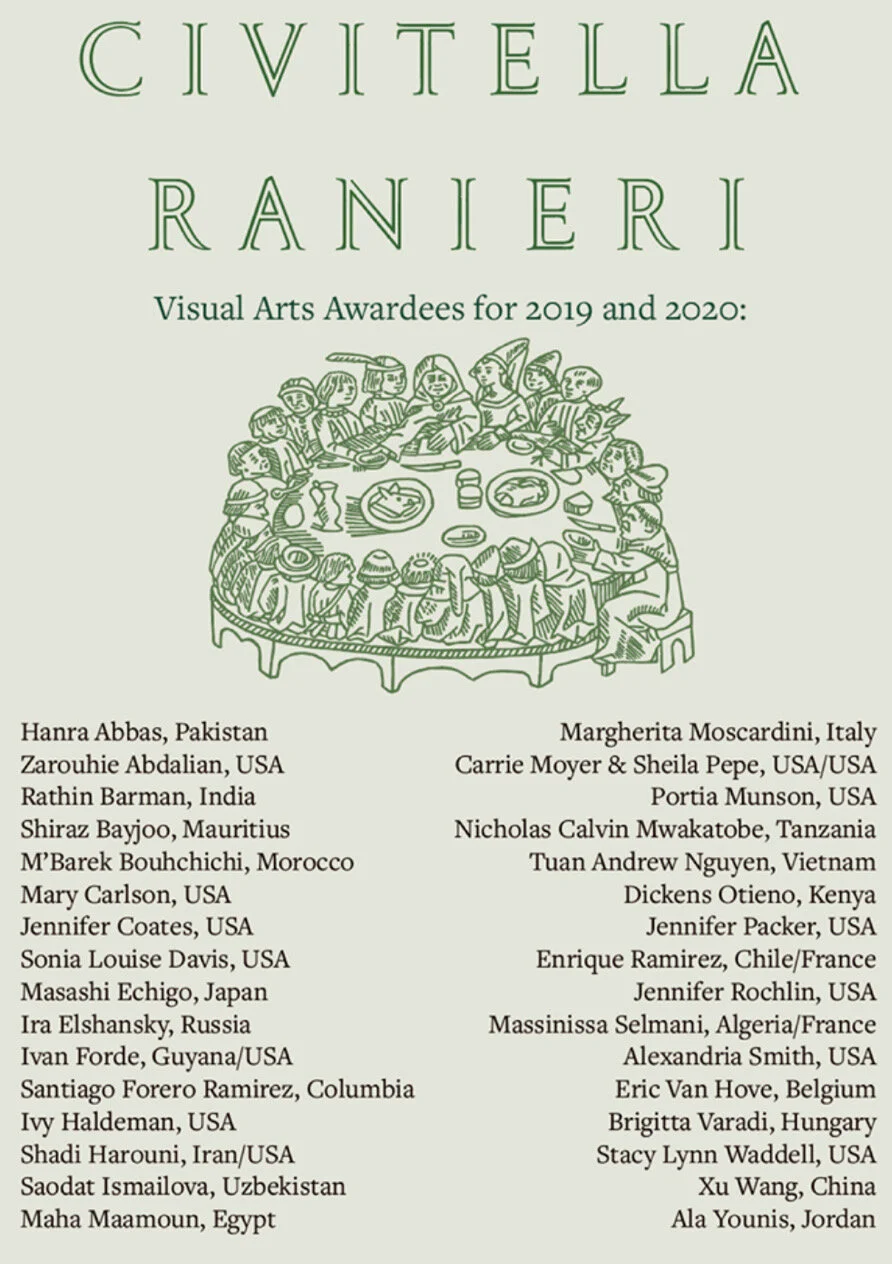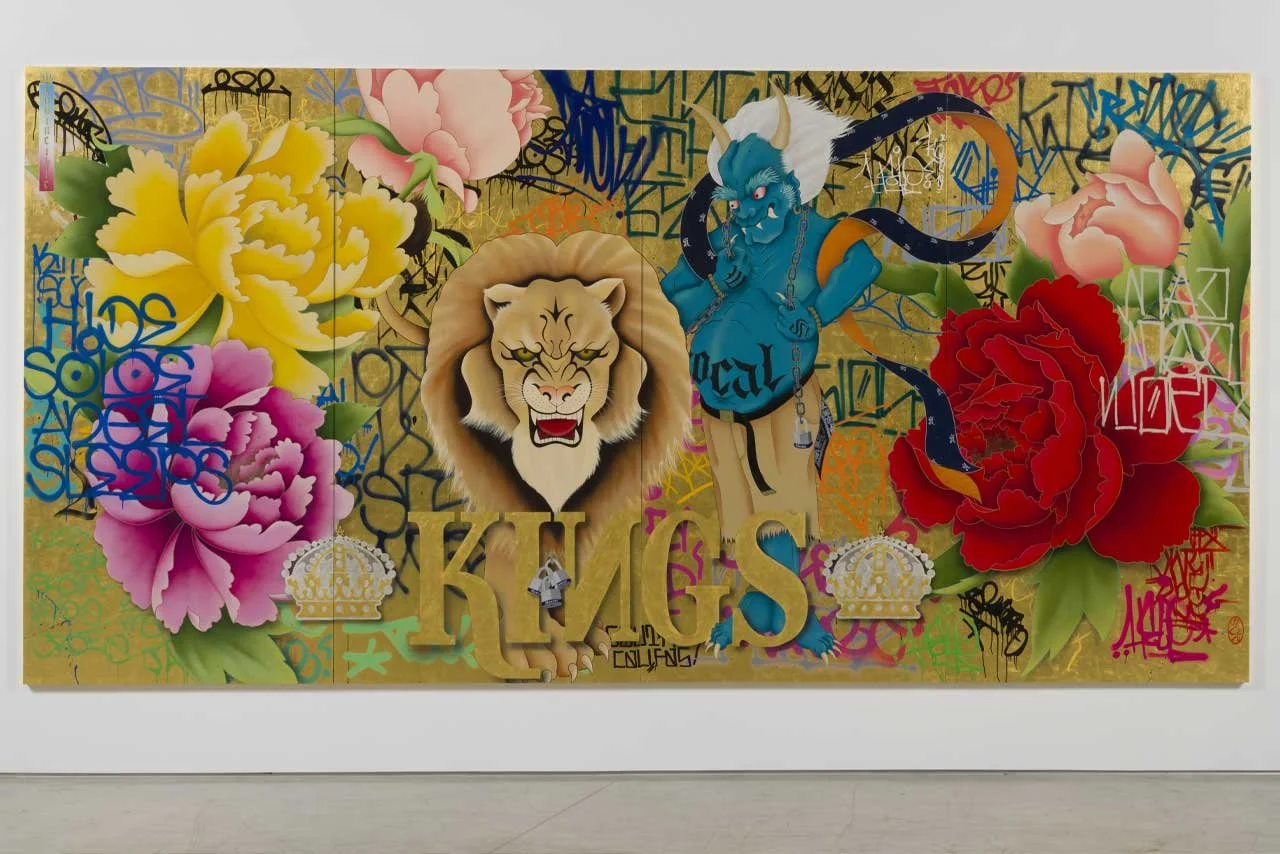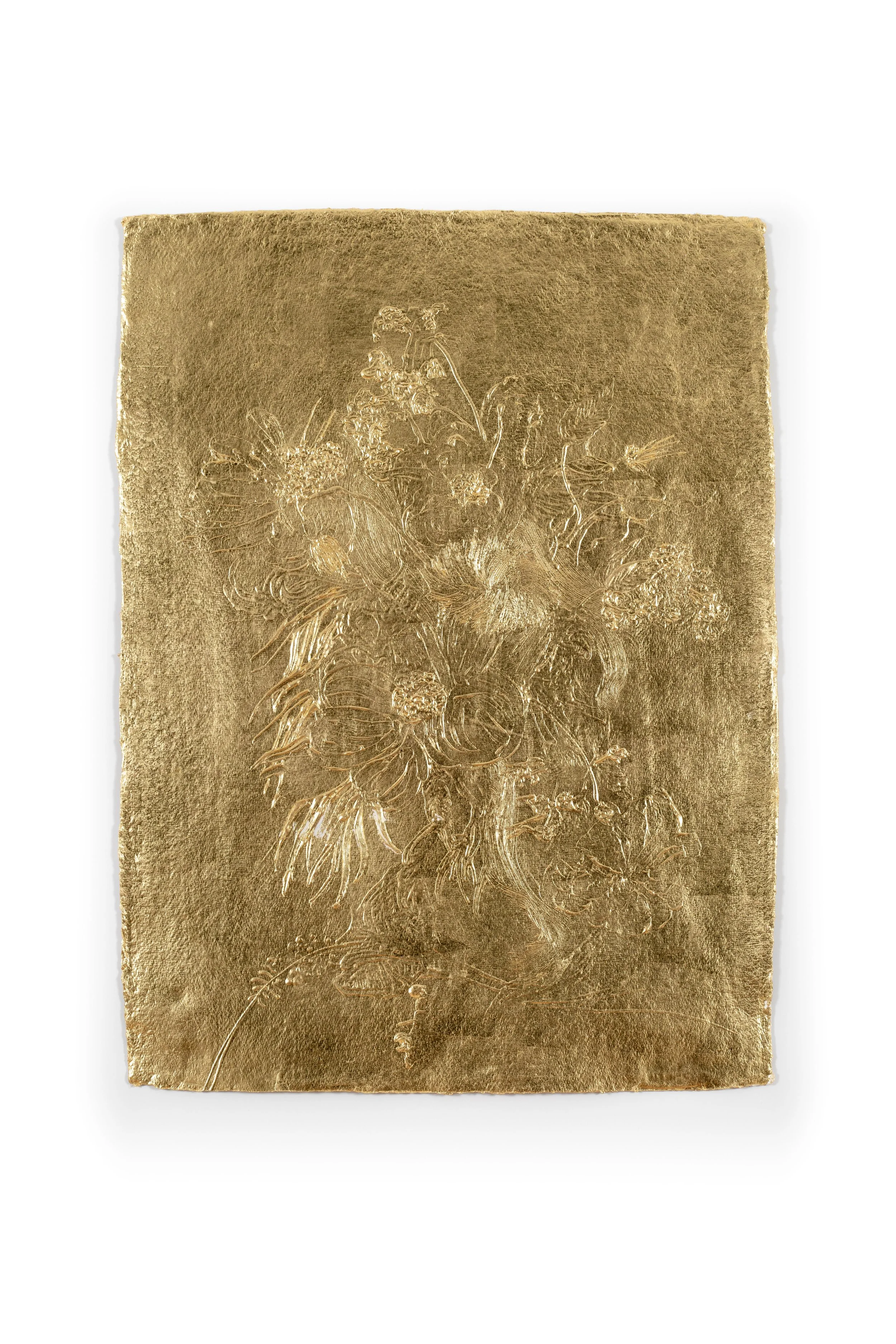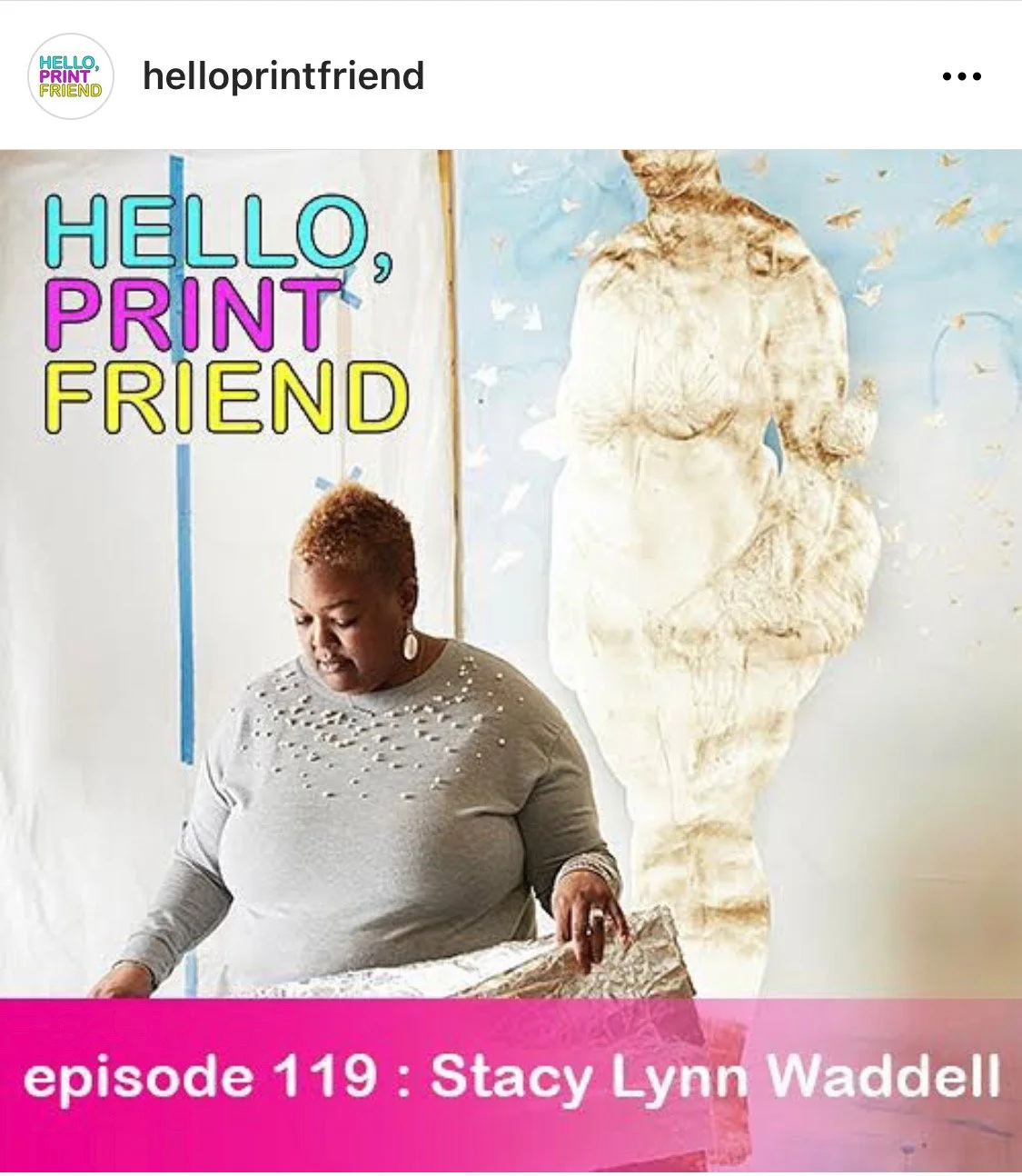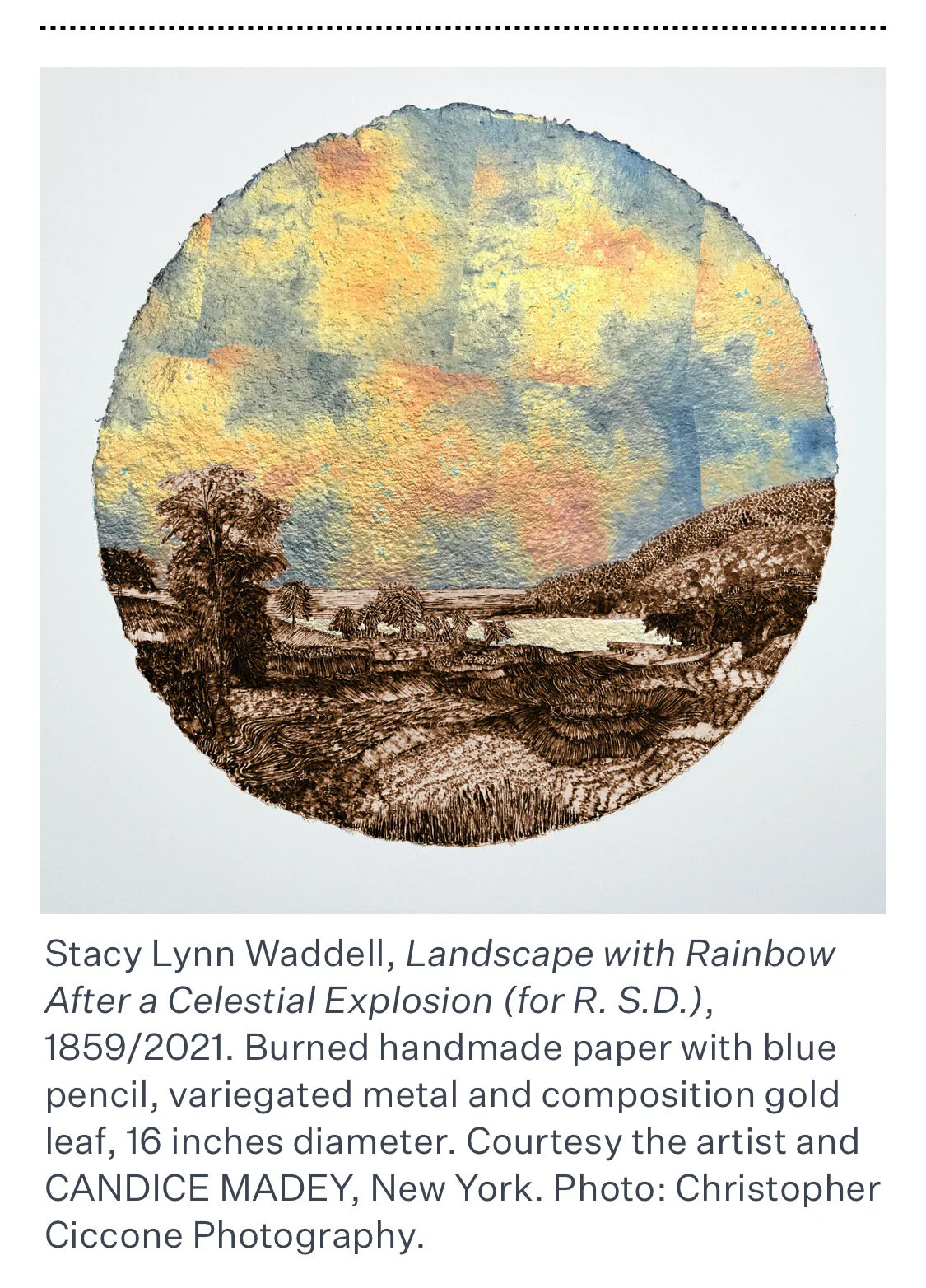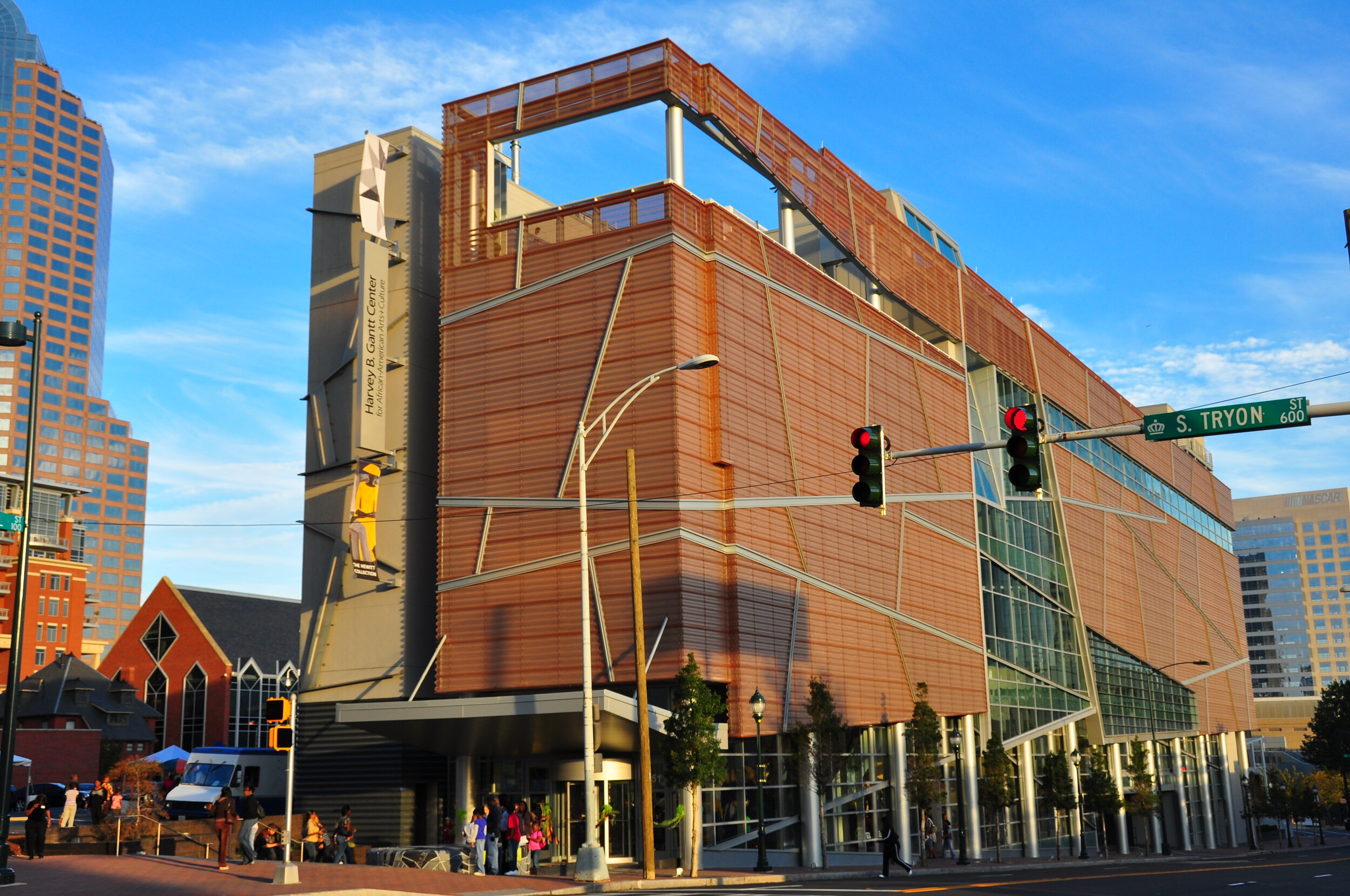Arthur and Sheila Prensky Island Press Visiting Artist
I am extremely excited to be named a Fall 2024 Arthur and Sheila Prensky Visiting Artist at Island Press. During my time in-residence, I will conduct a public talk, engage with students and create a print edition with Master Printer Tom Reed, the Island Press Team and art students from Sam Fox School of Design & Visual Arts at Washington University, St. Louis, Missouri.
Past Visiting Artists include:
Radcliffe Bailey
Trenton Doyle Hancock
James Siena
Nina Katchadourian
Shaun O'Dell
Lisa Sanditz
Henrik Drescher
Orly Genger
Beverly Semmes
Dario Robleto
Diana Guerrero-Maciá
Lisa Anne Auerbach
Diane Victor
Enrique Martínez Celaya
Duane Slick
Michael Joo
Erika Blumenfeld
Stephanie Syjuco
Meleko Mokgosi
Night Swimming: New American Paintings 2024 Summer Review Steven Zevitas Gallery, Boston, MA
Untitled (FLORAL RELIEF 1841), 2022, 22-karat gold on handmade paper,. 30 x 22 inches
July 12 - August 31, 2024
Public reception: Friday, August 2, 5:30 – 8 pm
Participating Artists:
Cindy Bernhard
Grace Bromley
Temi Edun
Shyama Golden
Nathan Hosmer Nevarez
Hannah Murray
Elbert Joseph Perez
David Shrobe
Ramón Vargas
Stacy Lynn Waddell
Jesse Zuo
light takes time to reach us
light takes time to reach us
CANDICE MADEY
1 Rivington Street
New York, NY 10002
September 6 - October 28, 2023
CANDICE MADEY is thrilled to announce the gallery’s second solo exhibition with Stacy Lynn Waddell, light takes time to reach us, presenting a series of landscapes composed of layers of precious metals; a suite of Audubon bird specimens, rendered in low-relief pastiglia and silver-leafed; and a single gilded portrait. Winslow Homer’s watercolor After the Hurricane, Bahamas, in which a lone figure appears washed ashore on a beach, is an important touchstone for the new body of work.
Waddell frequently sources imagery from 19th century American art and cites a particular fascination with the period’s spirit of unbridled optimism, rapid technological progress, and belief in manifest destiny, often represented by idealized landscapes. Painted in 1899, After the Hurricane, Bahamas characterizes Homer’s interest in the unpredictable weather conditions that he experienced while traveling in the tropics. Through a contemporary lens, the work seems to foreshadow the relationship with between extreme weather patterns, climate change, the dizzying effect of accelerated global exchange. Waddell echoes Homer’s setting in her own work, exploring how the origins of present-day environmental issues are deeply rooted in 19th century European and American policy and the Industrial Revolution.
Waddell further explore the complicated relationship between nature, economics, and hierarchical concepts of natural resources in a suite of silver leaf works that portray images from John James Audubon’s Birds of America. Specifically, Waddell interprets a hummingbird that was described in the book as “nondescript and difficult to determine,” suggesting its relative lack of consequence in comparison to showier specimens. While taxonomy was popular practice in 19th century natural sciences, Waddell probes how the practice of classification has propagated value systems that extend beyond the scientific into the social, ranking one group over another.
A single painting on canvas is based on a 1964 photograph by Malian artist Malick Sidibé, in which a man with his arms overhead dances the merengue, an Afro-Caribbean dance that originated in the Dominican Republic in the 19th century. In her work, Waddell frequently revisits the vibrant period of Malian history when an emboldened population was reinventing a new national identity (after more than 60 years of French colonial rule), proposing a vivid counterpoint to forms of patriotism in American history.
Whether working on paper or on canvas, Waddell uses wide array of processes to create lush texture, including gilding, embossing, and other unexpected approaches. The result is a temporal experience that requires movement and time to fully see her subject matter. She is candid about the seductive effect of reflective surfaces, further acknowledging that her use of gold, silver, and other precious metals alludes to entrenched, cultural notions of value and currency.
The title of the show, light takes time to reach us, is also the title of the artist’s first work in neon, offering a universal and transcendent alternative to nationalistic notions of history and identity.
Stacy Lynn Waddell’s solo exhibitions include Home House, Isabella Stewart Gardner Museum, Boston, MA; Mettle, CANDICE MADEY, New York, NY; Epitaph for A Darling Lady, Visual Arts Center of Richmond, Richmond, VA; and The Evidence of Things Unseen, Weatherspoon Art Museum, Greensboro, NC, and others. Recent group exhibitions include Spirit in the Land, The Nasher Museum of Art (curated by Trevor Schoonmaker); Get Lifted! The Art of the Ecstatic, KARMA, New York, NY (curated by Hilton Als); Taking Space: Contemporary Women Artists and the Politics of Scale, Pennsylvania Academy of the Fine Arts, Philadelphia, PA and The Montclair Art Museum, Montclair, NJ; Half the Picture: A Feminist Look at the Collection, Elizabeth A. Sackler Center for Feminist Art, Brooklyn Museum, Brooklyn, NY. Her work is in the collections of The Bristol Museum of Art and Gallery, The Brooklyn Museum, The Crystal Bridges Museum of American Art, The Gibbes Museum of Art, The Mint Museum, The Nasher Museum of Art, The North Carolina Museum of Art, The Pennsylvania Academy of the Fine Arts, The Princeton University Art Museum, The Studio Museum in Harlem, and The Weatherspoon Art Museum, among numerous other museums and private collections. Stacy was a Civitella Ranieri Foundation Fellow in Umbria, Italy in 2021, and in 2017, she was an Artist-in-Residence at Joan Mitchell Center in New Orleans. She was a 2010 recipient of the Joan Mitchell Foundation grant.
Stacy lives and works in North Carolina. She has an MFA from the University of North Carolina-Chapel Hill.
Image details: Stacy Lynn Waddell, Untitled #6 (awakening after the Gulf Stream and the Hurricane), 2023, Composition gold leaf, variegated metal leaf and Japanese colored silver leaf on handmade cotton/abaca paper with laser etching, 32 5/8 x 32 5/8 inches (framed). Photo credit: Kunning Huang
—
Callaloo: A Journal of African Diaspora Arts and Letters, Volume 41, Number 4, Johns Hopkins University Press
I was invited to submit two works for the front and back covers of Callaloo Volume 41, Number 4
Front Cover: THE TWO OF US CROUCHING DOWN WITH HALOS AS HATS (for M. S.), 1973/202160 x 48 inches, composition gold leaf on canvas
Back Cover: WOMAN IN A CHECKERED DRESS IN CONTRAPPOSTO (for M. S.), 1971/2021, 48 x 36 inches, composition gold leaf on canvas
New American Paintings: South #166, Volume 28, Issue 3 The Open Studios Press, Boston, MA
I am super excited to be selected from 1000 applicants to be included in New American Paintings South June/July 2023
Spirit in the Land
A View of Asheville, North Carolina under Dwindling Cloud Cover (for R. S. D.), 1850/2022, burned handmade paper with blue pencil, ink and aluminum leaf, 16 x 16 inches in diameter
Spirit in the Land
Nasher Museum of Art at Duke University
Durham, NC 27705
(February 16 – July 9, 2023)
Pérez Art Museum
Miami, FL
(March 21 – September 8, 2024)
Cummer Museum
Jacksonville, FL
(November 6, 2024 – February 9, 2025)
Spirit in the Land is a contemporary art exhibition that examines today’s urgent ecological concerns from a cultural perspective, demonstrating how intricately our identities and natural environments are intertwined. Through their artwork, thirty artists show us how rooted in the earth our most cherished cultural traditions are, how our relationship to land and water shapes us as individuals and communities. The works reflect the restorative potential of our connection to nature and exemplify how essential both biodiversity and cultural diversity are to our survival.
These artists explore the ways in which our inner spaces mirror our outer ones in works that both celebrate the profound beauty of our world and mourn its loss, and with it, vanishing histories of people and place.
As the battles against climate change are often most critical for marginalized communities— environmental justice is social and racial justice—the exhibition and catalogue center the voices of artists who approach ecological awareness through a close attention to the communities most negatively affected. Acting as environmental stewards, the artists reclaim and revitalize our understanding of nature as a repository of cultural memory, a place of sanctuary, a site of resistance, and a source of spiritual nourishment and healing. As land and water provide a sense of belonging and community, the exhibition illustrates our interdependence with all life on Earth.
Spirit in the Land has its roots in North America, with shoots reaching into the Caribbean. While these artists investigate natural environments under stress, the exhibition presents a belief in the possibility of transformation and regeneration. Our desire to live in harmony with nature is ultimately what will determine our future.
This exhibition is organized by Trevor Schoonmaker, Mary D.B.T. and James H. Semans Director, Nasher Museum.
Artists Incude: Terry Adkins, Firelei Báez, Radcliffe Bailey, Rina Banerjee, Christi Belcourt, María Berrío, Mel Chin, Andrea Chung, Sonya Clark, Maia Cruz Palileo, Annalee Davis, Tamika Galanis, Allison Janae Hamilton, Barkley L. Hendricks, Alexa Kleinbard, Hung Liu, Hew Locke, Meryl McMaster, Wangechi Mutu, Dario Robleto, Jim Roche, Kathleen Ryan, Sheldon Scott, Renée Stout, Monique Verdin, Stacy Lynn Waddell, Charmaine Watkiss, Marie Watt, Carrie Mae Weems, Peter Williams.
A Moon For A Sun
In October 2022, I will have the first European exhibition of my work. The project entitled A Moon For A Sun, features the most expansive of my Damaged Emergency Blankets. Primarily distressed paper and papery material, these pieces are simultaneously abstract two-dimensional fields and pliable sculptural stock that can be shaped into a variety of forms with varying levels of relief. Each piece becomes an ode to an iconoclast or event such as Thelma Butterfly McQueen, Octavia Butler or the Black and Blue Atlantic, etc. The original conceit for these pieces grew out of a fascination with the seemingly inert squares of Mylar used to deliver emergency sources of heat to runners, outdoor trekkers, victims of circumstance, etc
Metal of Honor: Gold From Simone Martini To Contemporary Art @ Isabella Stewart Gardner Museum
Discover the allure and significance of one of the world’s most precious metals this fall at the Gardner. Metal of Honor: Gold from Simone Martini to Contemporary Art explores how four artists, of different times and different places, use gold as an artistic strategy for innovation and honor. Works by Simone Martini (c. 1284-1344, Italy), whose novel compositions and masterful techniques were unequaled in Europe and well ahead of his time, are juxtaposed with works by three contemporary painters—Titus Kaphar (b. 1976, US), Stacy Lynn Waddell (b. 1966, US), and Kehinde Wiley (b. 1977, US). These artists reinterpret the style and medium of devotional imagery to explore the meaning of representation, commemoration, and adoration today. The exhibition features stunning examples of Martini’s skilled manipulation of gold and the sacred symbolism it evokes, including the Gardner’s five-panel altarpiece and its smaller painting, Virgin and Child with Saints. These pieces are the first two works by the artist in the United States, a testament to our founder’s pioneering tastes. A new film explores goldwork techniques used in Martini’s time and today.
Metal of Honor: Gold From Simone Martini To Contemporary Art, installation view, Hostetter Gallery, Isabella Stewart Gardner Museum, Boston, MA, October 13, 2022 - January 16, 2023
Home House - Anne H. Fitzpatrick Facade @ Isabella Stewart Gardner Museum
Stacy Lynn Waddell (b. 1966, US) is an American artist who explores the storytelling power of portraits and how society articulates its values and social hierarchies visually through portraiture. She focuses on the correspondence between art historical narratives and economic, political, and social structures, probing the contradictions and misperceptions of American culture through the allegory of her own personal story.
Waddell is the self-appointed archivist of her family and has spent many long hours researching her family’s origin story. The young woman in this photograph is the artist's maternal grandmother, Anliza Massenburg Gill, on a visit to New York City. She was a firm believer in community and family, and together with her husband Otis Gill, raised seven children, who have continued to thrive across generations at home house On-The-Hill on their treasured farm and pasture lands in North Carolina. By placing this photograph on the Façade, Waddell honors her dearly loved grandmother in a way that speaks to the lasting impact of portraiture.
Home House can be enjoyed by all on the exterior of our building on Evans Way and by ticketed visitors from inside the Museum’s walled garden. Additional works by the artist are featured in the exhibition Metal of Honor: Gold from Simone Martini to Contemporary Art on view through January 16, 2023.
CIVITELLA RANIERI Fellowship
In 2022, I will end the year as a Fellow-in-Residence at Civitella Ranieri in Umbria, Italy. During my residency, I will be conducting research, making drawings and learning to marble paper while living in a 15th century castle. My six-week residency will take place September 21 - October 31, 2022.
Gilded: Contemporary Artists Explore Value and Worth @ Weatherspoon Art Museum
Across time and cultures, gold has served as a metaphor for what we value most. Symbolically, it stands in for goodness, excellence, brilliance, and wealth. He has a heart of gold. She is going for gold. It shone like gold. They struck gold. Found in crowns and regalia that bestow power, rings that signal matrimony, and currency traded among peoples, the metal has profound social significance.
Across the arts, craftspeople have long pounded gold into thin sheets called leaves, which are applied in a process called gilding. In realms of the spiritual, gilding illuminates sacred texts, gives otherworldly luster to holy spaces, and allows religious sculptures to shine.
While we most frequently associate gold leaf with historic traditions, the material appears frequently in the work of contemporary artists. Specifically, the artists represented in this exhibition turn to gilding as a means to reconsider our value systems. Gilding images of graffiti and sidewalks, cardboard boxes and architectural fragments, they ask us to see the beauty in what we so often overlook and honor that which we so often throw away. Gilding images of people—often those who have been disempowered or forgotten—they ask us to hold up our collective humanity. If, as the saying goes, “all that glitters is not gold,” the artists represented here offer an inverse proposition: perhaps that which does not always shine is most worthy of our attention.
Gilded features the work of Radcliffe Bailey, Larissa Bates, william cordova, Angela Fraleigh, Gajin Fujita, Nicholas Galanin, Liz Glynn, Shan Goshorn, Sherin Guirguis, Titus Kaphar, Hung Liu, James Nares, Ronny Quevedo, Shinji Turner-Yamamoto, Danh Vo, Stacy Lynn Waddell, and Summer Wheat. The exhibition is accompanied by a scholarly catalogue including contributions by art historian Rebecca Zorach and poet Joshua Bennett. After its Weatherspoon debut, the project will travel to the Hunter Museum of Art in Chattanooga, TN and the Hood Museum of Art at Dartmouth in Hanover, NH.
Gilded is organized by Dr. Emily Stamey, curator and head of exhibitions.
Untitled (Floral Relief 1661), 2022, 22-karat gold leaf on handmade paper
CAPITOL, INC. ICAR Augmented Reality Public Art Commission
Artist Stacy Lynn Waddell throws an emergency blanket over the National Mall reflecting pool illustrating the climate emergency. Her installation combines scientific data with her virtual installation taking her viewers through history as you watch the consequences of global warming worsen over time.
The emergency blanket takes global warming trends to a new level as it allows the viewer to jump through the history of our planet's destruction. This piece ties in how oil & gas industries pump money into controlling a well-oiled political machine that funds policies that prioritize corporate profits at the expense of the environment.
Stacy Lynn Waddell creates works that structure sites of intersection between both real and imagined aspects of history and culture. With a variety of transformative processes that include heat/laser technology, accumulation, embossing /debossing, interference, and gilding, these points of intersection pose important questions related to authorship, beauty, and the persuasive power of nationalistic ideology. The artist splits her time between North Carolina and New York.
WHAT OCTAVIA E. BUTLER SAW WHEN SHE LANDED AT THE SITE, 2021
"Formally, when you look at them, a big giant crinkle sheet of paper that you can then continue to shape. The other thing about these blankets is that can be shaped into forms, right? They could be folded like a tapestry. And that kind of like every time you change the form or shape of it, it holds the memory of what you did to it prior, and that's what the environment does, right? It holds the memory of what we're doing to it, of everything we've done to it." Waddell
Episode 119: HELLO, PRINT FRIEND Podcast with Miranda Metcalf
This week on Hello, Print Friend Miranda speaks with Stacy Lynn Waddell. We’ll talk about her use of branding irons as printmaking, the late great actress Butterfly McQueen, and living a slow life in a manic world. Hello, Print Friend is made with love on location in Santa Fe, New Mexico and Spokane, Washington.
Stacy Lynn Waddell in her studio, 2020 Photo: Olly Yung for Matrons & Mistresses
Mettle
CANDICE MADEY is pleased to announce Stacy Lynn Waddell’s first solo exhibition in New York, Mettle, presenting new paintings and works on paper. Works in Mettle reference historical periods typically described as the “Golden Ages,” addressing the intersection of popular culture and history with issues related to visibility, desire, and power.
Waddell focuses on three distinctive “Golden Ages” from Africa, North America and Europe: Malian culture of the 1960s, 19th century American painting, and 17th century Dutch flower painting. Through a slow and reflective studio practice, she considers the authorship and idealism of art historical narratives and how they correspond to the economic and political structures of their time.
Waddell’s subject matter includes floral motifs, landscapes, and figuration, following the distinctive trends of different cultural eras. Here, Waddell includes Dutch vanitas and pronkstillevens painting—created alongside the birth of global trade, corporate finance, and central banking systems; American painter Robert S. Duncanson’s Landscape with Rainbow (as it relates to 19th century concepts of progress and exceptionalism); and the photography of Malick Sidibé, which captured the post-independence exuberance of Malian music in the 1960s.
Source images are transformed by a variety of processes, including burning paper using laser technology, embossing and debossing, physical distressing, and (most visibly in this exhibition), gilding. Waddell’s use of gold leaf addresses the material’s associations with value and trade, and the historic role of the gold standard in establishing modern banking and the distribution of wealth.
Gilded works allow for the construction of monochromes and provocative optical effects, much like that of a hologram. Images cannot be fully seen from one vantage point; textured surfaces and modulations in shine require the viewer to physically shift positions in order to fully view the image. The work’s dependence on light and the surrounding environment ensure that the image is never fixed, complicating the observational process, and forcing a slower, more deliberate consideration.
The exhibition title, Mettle, is a variant of “metal” that dates to the 16th century, and describes a resilient, strong, or fighting spirit. Mettle is persistently visible in Waddell’s figurative work—an attribute that Waddell uses to question entrenched historical structures, troubling the discourses of power therein.
Waddell’s work is in the collections of The Nasher Museum of Art, The Weatherspoon Art Museum, The North Carolina Museum of Art, The Gibbes Museum of Art, The Studio Museum in Harlem, The Brooklyn Museum, The Pennsylvania Academy of the Fine Arts, and The Crystal Bridges Museum of American Art. She has participated in exhibitions at The Studio Museum in Harlem and The Brooklyn Museum in New York; Nasher Museum of Art, Durham; Weatherspoon Art Museum, Greensboro; The North Carolina Museum of Art, Raleigh; The Pennsylvania Academy of the Fine Arts, Philadelphia; Institute of Contemporary Art, Boston; Columbia College, Chicago; Speed Art Museum, Louisville; Atlanta Contemporary, among other venues.
Waddell was a recipient of the Joan Mitchell Foundation grant (2010), an Artist-in-Residence at Joan Mitchell Center in New Orleans (2017) and at QueenSpace in New York (2019). She has an MFA from the University of North Carolina-Chapel Hill and lives and works in North Carolina.
Image: THE TWO OF US CROUCHING DOWN WITH HALOS AS HATS (for M. S.), 1973/2021, installation view, Mettle, CANDICE MADEY, New York, NY, 2021, composition gold leaf on canvas, 60 x 48 inches
Photography: Kunning Huang
Get Lifted! The Art of the Ecstatic
Get Lifted!
organized by Hilton Als
August 19-October 2, 2021
Karma
22 East 2nd Street
New York, NY, 10003
Diane Arbus, Anthony Barboza, Peter Bradley, Jared Buckheister, Alice Coltrane, Somaya Critchlow, Brett Goodroad, Louise Fishman, Marley Freeman, Lee Friedlander, Reggie Burrows Hodges, Andrew Lamar Hopkins, Peter Hujar, Siobhan Liddell, Glenn Ligon, Jesse Murry, Ana Mendieta, Alice Neel, Senga Nengundi, Dan Nicoletta, Edward Owens, Paul Pfeiffer, Ntozake Shange, Gertrude Stein & Virgil Thomson, Tabboo!, Paul Thek, James Van Der Zee, Stacy Lynn Waddell, Kelley Walker, Frank Walter, and Jack Whitten
Karma is pleased to present Get Lifted!, an exhibition organized by Hilton Als.
In 1951, the painter Dorothea Tanning created Interior with Sudden Joy. In this detailed, haunting piece, the late American-born painter and poet focuses on two female figures, their arms around each other in an unidentifiable space. One of the young women plays with a shaggy dog, while the other looks toward a dark nude figure who clings to a tree or some other biomorphic shape. Beyond these three, there is another person, gender-nonspecific, standing in darkness beyond an open door and holding a light-filled sphere. Rendered with great precision, Interior with Sudden Joy emphasizes how light illuminates darkness and changes it. The painting is a depiction of the surprise and freedom that a work of art—or a dream—can generate.
Painted near the start of what feels like our permanent Cold War, Tanning’s work is a detail-rich explosion of energy and insight that grew out of a repressive time. Similarly, Get Lifted! is an examination and celebration of how, in dark times and just after, the artist’s creative process can reaffirm life in its effort to describe it. In this group exhibition featuring artists ranging from Diane Arbus and Peter Hujar to Louise Fishman and Reggie Burrows Hodges, the viewer is treated to works in a variety of media—painting, film, photography—that, essentially, describe faith: in the transgressive body, in political freedom, in ecclesiastical belief, in sexual forthrightness and desire, in the release from the corporeal to the spiritual and, thus, the ecstatic.
Ecstasy, from the Greek ekstasis, meaning to “to stand outside or transcend oneself,” can be an opportunity of sorts for artists who are interested in carrying themselves and their audience beyond previously accepted forms of art, music, literature, dance, performance. Hard times can bring about an explosion of change, a view toward transformation. In Get Lifted!, visual artists such as Ana Mendieta and Paul Pfeiffer remake figures into something else, or make the figure disappear, while Jared Buckhiester and Stacy Lynn Waddell use the privacy of isolation as an occasion for their subjects to undergo some sort of transformation. Get Lifted! also showcases the work of creators who not only transformed their genre but mined the ecstatic over and over. The legendary pianist, harpist and composer Alice Coltrane, and the poet, performer, and playwright Ntozake Shange both, in their own way, expressed what Shange described so trenchantly in her 1972 poem, “My Father is a Retired Magician”:
my father is a retired magician
which accounts for my irregular behavior […]
& the reason i’m so peculiar’s
cuz i been studyin up on my daddy’s technique
& everythin i do is magic these days
& it’s very colored
very now you see it/ now you
dont mess wit me
Collectively, these seminal artists had a profound effect on American culture from the 1940s on. Their work is a testament to the ecstatic and to how the ecstatic impulse can change not only art but the society that produces it. The visual artists of Get Lifted! demonstrate how art married to the spirit can lift us up collectively, one at a time.
—Hilton Als
ART PAPERS Spring 2021 Issue: Mimicry, Camouflage, Transformation
In 2020, I was commissioned to produce an ART PAPERS Artist Project for the Spring 2021 Issue: Mimicry, Camouflage, Transformation. With this series of drawings, I have combined my usual lineup of materials, tools and transformative processes to build surfaces that mimic naturalistic elements and particular environmental conditions.
Taking Space: Contemporary Women Artists and the Politics of Scale Pennsylvania Academy of the Fine Arts, Philadelphia, PA
Taking Space: Contemporary Women Artists and the Politics of Scale examines the approaches of women artists for whom space is a critical feature of their work, whether they take the space on a wall, the real estate of a room through sculpture and installation, engage seriality as a spatial visual practice, cast a wide legacy in art history or claim the space of their body. This exhibition invites viewers to consider how size and repetition can be interpreted as political gestures in the practices of many women artists.
Featured artists include Mequitta Ahuja, Polly Apfelbaum, Jennifer Bartlett, Maria Berrío, Chakaia Booker, Emily Brown, Joan Brown, Tammy Rae Carland, Squeak Carnwath, Vija Celmins, Elizabeth Colomba, Njideka Akunyili Crosby, Eiko Fan, Louise Fishman, Audrey Flack, Mary Frank, Viola Frey, Hope Gangloff, Judy Gelles, Nancy Graves, Guerrilla Girls, Ellen Harvey, Clarity Haynes, Orit Hofshi, Barbara Kruger, Winifred Lutz, Vanessa Marsh, Ana Mendieta, Leah Modigliani, Elizabeth Murray, Wangechi Mutu, Alice Neel, Dona Nelson, Louise Nevelson, Ebony G. Patterson, Liliana Porter, Debra Priestly, Ana Vizcarra Rankin, Faith Ringgold, Mia Rosenthal, Brie Ruais, Betye Saar, Miriam Schapiro, Mira Schor, Alyson Shotz, Sylvia Sleigh, Becky Suss, Mickalene Thomas, Stacy Lynn Waddell, Marie Watt, Dyani White Hawk and Deborah Willis.
Featuring works from the permanent collection, including many recent acquisitions, Taking Space is one of three exhibitions at PAFA in 2020–2021 celebrating women artists in honor of the 100th anniversary of the passing of the 19th Amendment to the U.S. Constitution, which granted women the right to vote.
Graphic Pull: Contemporary Prints from the Collection Nasher Museum of Art at Duke University Durham, NC
Graphic Pull: Contemporary Prints from the Collection highlights numerous printmaking techniques from the Nasher Museum’s collection with works dating from the 1970s to today. Including both traditional and unconventional printing methods, the exhibition explores how contemporary artists have continued to use this age-old graphic form while also expanding on its processes and definitions. Whether pulled from a press or printed by hand, the works on view emphasize the irresistible qualities of the medium that have made it an effective means of artistic expression for millennia.
The inherent characteristics of most prints—reproducibility, general ease of distribution, and collaborative elements—make them particularly efficient at communicating ideas to large audiences. Because of this, many prints on view in Graphic Pull address issues related to current, or recurring, social and political trends and events. Recent acquisitions, prints from the collection that have never been on view, and several loans have been included for their effectiveness in conveying such issues as well as for their ability to broaden the discussion of what a print can be. Historical prints also provide valuable source material for artists considering their relevance today.
In a world that has recently changed so rapidly and profoundly, prints have played a vital role for their ability to educate, advocate, and inspire. Their graphic pull moves makers and viewers alike to participate in addressing urgent issues around the globe. Through a range of approaches, contemporary prints continue to harness the medium’s potential in powerful and innovative ways, one pull at a time.
Artists include Emma Amos, Hurvin Anderson, Kathryn Andrews, Nava Atlas, Judith F. Baca, Camille Billops, Mark Bradford, Roger Brown, Bruce Conner, David Driskell, Bill Fick, Juan Genovés, the Guerrilla Girls, David Hammons, Lubaina Himid, Sedrick Huckaby, Barbara Kruger, Pedro Lasch, Justin Matherly, Grayson Perry, Raymond Pettibon, Michelangelo Pistoletto, William Pope.L, Dmitri Prigov, Colin Quashie, The Bruce High Quality Foundation, Barthélémy Toguo, Stacy Lynn Waddell, Andy Warhol and Xu Bing, among others.
Graphic Pull: Contemporary Prints from the Collection is organized by Molly Boarati, assistant curator at the Nasher Museum of Art at Duke University.
Future Texts
TEN AT SEVEN
Presented by the SJ Weiler Fund
FUTURE TEXTS
Chitra Ganesh
Cauleen Smith
Stacy Lynn Waddell
Saya Woolfolk
TEN AT SEVEN is an annual curatorial project hosted by the SJ Weiler Fund, a foundation supporting the visual and performing arts. Presenting contemporary and historic artworks by artists of culturally diverse backgrounds who engage with history, politics, and social issues, the project comprises an exhibition, a publication, and gatherings hosted by collector Susan Weiler in her West Village home.
Throughout the duration of the exhibition, small gatherings of artists, colleagues, and friends will be held at 7pm, for dinner, drinks, performances, and dialogue inspired by the artists’ works. The installation will be available for viewing online and by appointment.
TEN AT SEVEN’s second exhibition, Future Texts, is inspired by sociologist Alondra Nelson’s eponymously titled essay exploring the social and racial biases embedded in the systems of science and technology. Written in 2002, around the advent of Web 2.0, Nelson’s essay critiques theoretical frameworks of a networked world—such as Marshall McLuhan’s concept of the “global village” and oversimplified views of the “digital divide”—which she believes present technological progress as oppositional to black culture. She further probes the racially coded visual cues of science fiction, futurism, and so-called primitivism, and examines how these narratives relate to systematic racism inscribed in broader American history and culture.
Nelson advocates for a new futurism in which more diverse voices express their histories and reclaim programmatic power of their technologies and their tools. She finds inspiration in Ishmael Reed’s 1972 novel Mumbo Jumbo, in which Reed questions who owns the right to determine the knowledge systems of the future, insisting that, “We will make our own future Text.”
In this spirit, Future Texts explores notions of progress and technology as defined by artists and their processes. The exhibiting artists are equally grounded in their unique cultural traditions, proposing personal visions of the future that redress history and expose and revoke the cultural and gendered biases of outmoded techno-narratives.
On view online and by appointment Fall 2020.
A fully illustrated catalogue will accompany the exhibition.
For further information, please contact
info@stellarprojects.nyc
PRIZM ART FAIR
In December, I will participate in the seventh annual PRIZM ART FAIR. This iteration of the fair will will take place December 2-8, 2019 in Downtown Miami at the Alfred I. DuPont Building, 169 E Flagler Street, Miami, Florida 33131.
2019 Conceptual Focus
Love in the Time of Hysteria
“…There is another path. Love dignity and freedom manifested in those whose life’s quests is its ongoing achievement. Love those whom the systems of hatred deem worthless except as cheap labor, property, or moments of base pleasure. Radicalize that love. Don’t only love them but also love being loved by them. Value bringing value to and receiving value from those whom oppression claims lack value. Embody freedom through not only writing what one likes, as the martyred revolutionary Black physician and philosopher Steve Bantu Biko declared, but also loving each other with fierce defiance.”
- Lewis R. Gordon
Love in the Time of Hysteria illustrates how love, compassion, and respect endure in a social milieu riddled with divisive political rhetoric, unprovoked inflammatory attacks on members of marginalized communities, and broad societal malaise as a result of economic inequity. Love in the Time of Hysteria questions how these factors can alter and transform our natural disposition to love fully and replace love with a mindset motivated by fear, intolerance, and scarcity. In essence, love and ultimately sanity takes a backseat to the basic need to survive. Love does not only impact our interpersonal relationships but also provides the foundation for flourishing communities. Love, when deployed aptly, lives in the narratives we pass on to our children, sours in the untold and reclaimed histories of our ancestors and builds bridges of understanding between estranged communities.
How are we perceiving love? How do we express love under these circumstances? How do we improvise when we do not get the love we need? How do we love ourselves with sweet defiance? Do we deny ourselves love as a byproduct of social conditioning? What movements do we create to build a sense of community that is rooted in love?
These notions will be explored through a presentation of works in various media that include: drawings, painting, video, photography, sculptures, installation, and new media.
PAINTING IS ITS OWN COUNTRY
In November, I will participate in an exhibition entitled Painting Is Its Own Country curated by Dexter Wimberly. This survey of contemporary painting will include the work of 25 artists representing various regions of the United States and be on view through May 3, 2020 at the Harvey B. Gantt Center for African-American Arts + Culture (Charlotte, NC).
